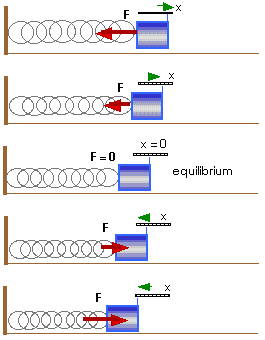

Motion that repeats itself is periodic motion. A particular kind of periodic motion is known as simple harmonic motion. When an object is disturbed from equilibrium, its motion is probably simple harmonic motion. Here are some examples of periodic motion that approximate simple harmonic motion:



A particular and useful kind of periodic motion is simple harmonic motion (SHM). Our prototype for SHM is a mass attached to a spring.

The amplitude is the maximum distance the mass moves from its equilibrium position. It moves as far on one side as it does on the other.
The time that it takes to make one complete repetition or cycle is called the period of the motion. We will usually measure the period in seconds.
Frequency is the number of cycles per second that an oscillator goes through. Frequency is measured in "hertz" which means cycles per second.
Period and frequency are closely connected; they contain the same information.
f = 1/T
An interesting and important characteristic of all simple harmonic motion is that the period remains the same even for motions with quite different amplitudes.




Circular motion is another example of motion whose period is independent of the amplitude. Two riders on a merry-go-round have the same period even tho' one sits near the edge and has a large amplitude while the other sits near the axis of rotation and has a small amplitude.
|
|
|
||
(C) 2003, Doug Davis; all rights reserved